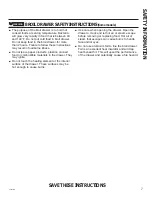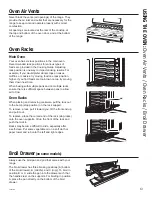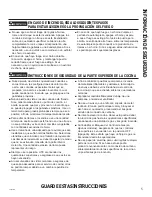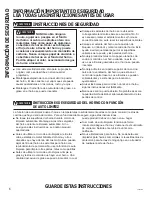
49-85209-6
15
Your new oven has a variety of cooking modes to help you get the best results. These modes are described below.
Refer to the Cooking Guide section for recommendations for specific foods. Remember, your new oven may perform
differently than the oven it is replacing.
Bake
The bake mode is for baking and roasting. This mode
uses heat from the lower burner. When preparing baked
goods such as cakes, cookies, and pastries always
preheat the oven first. Follow recipe recommendations
for food placement. If no guidelines are provided
center food in the oven. Turn the knob to the correct
temperature setting.
Broil
Broiling is done in either your oven cavity or broiling
drawer depending on the features of your model. Always
broil with the door closed. Monitor food closely while
broiling. Use caution when broiling on upper rack positions
as placing food closer to the broil burner increases
smoking, spattering, and the possibility of fats igniting.
Try broiling foods that you would normally grill. Adjust
rack positions to adjust the intensity of the heat to the
food. Place foods closer to the broil burner when a
seared surface and rare interior is desired. Thicker foods
and foods that need to be cooked through should be
broiled on a rack position farther from the burner.
Cookware
Cookware Guidelines
The material, finish, and size of cookware affect baking
performance.
Dark, coated and dull pans absorb heat more readily
than light, shiny pans. Pans that absorb heat more
readily can result in a browner, crisper, and thicker crust.
If using dark and coated cookware check food earlier
than minimum cook time. If undesirable results are
obtained with this type of cookware consider reducing
oven temperature by 25º F next time.
Shiny pans can produce more evenly cooked baked
goods such as cakes and cookies.
Glass and ceramic pans heat slowly but retain heat well.
These types of pans work well for dishes such as pies
and custards.
Air insulated pans heat slowly and can reduce bottom
browning.
Keep cookware clean to promote even heating.
Cooking Modes
USING THE O
VEN:
Cooking Modes / Cook
w
ar
e / Aluminum Foil and O
ven Liners
CAUTION
Do not use any type of foil or oven liner to cover the oven bottom. These items can block air-
flow or melt, resulting in damage to the product and risk of carbon monoxide poisoning, smoke or fire. Dam-
age from improper use of these items is not covered by the product warranty.
Foil may be used to catch spills by placing a sheet on a lower rack, several inches below the food. Do not use more
foil than necessary and never entirely cover an oven rack with aluminum foil. Keep foil at least 1-1/2” from oven walls
to prevent poor heat circulation.
Aluminum Foil and Oven Liners
















































